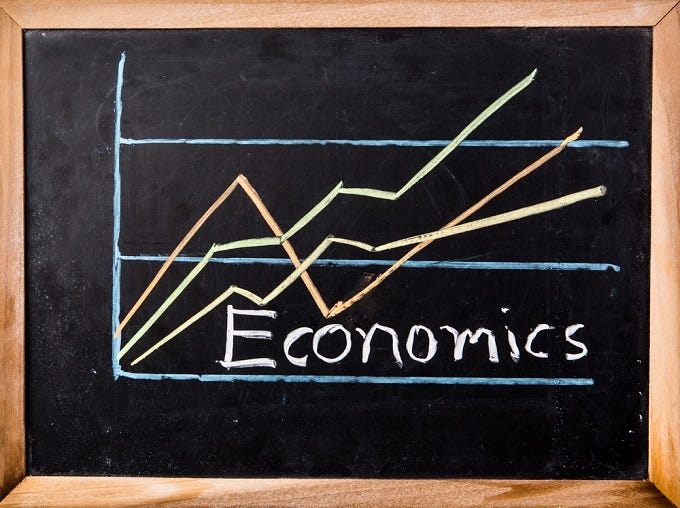Economists make the assumption that there are a large number of different buyers and sellers in the marketplace for each good or service available. This means that we have competition in the market, which allows price to change in response to changes in supply and demand. For example, if the price of a good is very high and some firms are making extra profits in that sector, other firms will be induced to start producing that same good – in competition with the others – which will increase supply and reduce the selling price. Furthermore, for almost every product there are substitutes, so if one product becomes too expensive, a buyer can choose a cheaper substitute instead (recall the section on elasticity). In a market with many buyers and sellers, both the consumer and the supplier have equal ability to compete on price.
Adam Smith in the 18th century recognized that competition between producers is crucial for the invisible hand to keep an economy efficient. Smith imagined a primitive society with only two products: beaver and deer. A hunter can produce only one type of game and therefore must choose whether to hunt for beaver or deer each day. If given the same effort, a deer sells for twice as much as a beaver, people will switch from beaver production to hunt deer instead. The result is more deer and less beaver, so the profit rates for deer begin to decline as beaver increases. Smith predicted that in a world of competition, the profit rates for all industries will converge to the same rate of profit, since if it becomes more profitable to be in a certain line of business, new companies will pop up to exploit that difference – pushing it back in line in the process.

Economists call this assumption about competitive producers perfect competition. Perfect competition is characterized by many buyers and sellers, many products that are similar in nature and, as a result, many substitutes. Perfect competition means there are few, if any, barriers to entry for new companies, and prices are determined by supply and demand. Thus, producers in a perfectly competitive market are subject to the prices determined by the market and do not have any leverage. For example, in a perfectly competitive market, should a single firm decide to increase its selling price of a good, the consumers can just turn to the nearest competitor for a better price, causing any firm that increases its prices to lose market share and profits. Take for example corn farmers. Many hundreds of farmers all produce an identical product: corn. Buyers do not care which farmer sells them their corn, and so buyers’ only concern is the price of corn. Therefore, the lowest priced corn seller will sell the majority of corn. If a corn seller cannot compete because his cost of production is too high, he will be forced to find ways to lower his costs or risk going out of business.
Monopoly and Oligopoly
In some industries, however, we find that there are no good substitutes and there little competition. In a market that has only one or few suppliers of a good or service, the producer(s) can control price. Consequently, consumers do not have much choice.
A monopoly is a market structure in which there is only one producer and seller for a product. In other words, the single business is the entire producer in the industry. Entry into such a market can be restricted due to high costs or other impediments, which may be economic, social or political that keep potential competitors out. For instance, a government can create a monopoly over an industry that it wants to control, such as electricity. Another reason for the barriers against entry into a monopolistic industry is that oftentimes, one entity has the exclusive rights to a natural resource. For example, in Saudi Arabia the government has sole control over the oil industry. A monopoly may also form when a company has a copyright or patent that prevents others from entering the market. Pfizer, for instance, had a patent on Viagra. Most economists agree that monopolies are inefficient since without competition, they can keep prices artificially high.
In an oligopoly, there are only a few firms that make up an industry. This select group of firms has control over the price and, like a monopoly, an oligopoly has high barriers to entry to keep out potential competitors. The products that the oligopolistic firms produce are often nearly identical and, therefore, the companies, which are competing for market share, are interdependent as a result of market forces. Assume, for example, that an economy needs only 100 widgets. Company X produces 50 widgets and its competitor, Company Y, produces the other 50. The prices of the two brands will be interdependent and, therefore, similar. So, if Company X starts selling the widgets at a lower price, it will get a greater market share, thereby forcing Company Y to lower its prices as well. In certain cases, types of oligopolies (for example cartels) are illegal.
Economics Basics: Production Possibility Frontier, Growth, Opportunity Cost and Trade
-
 Insights
InsightsHow and Why Companies Become Monopolies
Without competition, monopolies can raise prices and lower quality, leaving consumers little choice. But monopolies can benefit consumers as well. -
 Investing
InvestingI Can't Believe It's Corn!
The widespread use of corn spans from food additives to fuel, aspirin and windshield washer fluid. Find out where else it's used and the size of this growing industry. -
 Investing
InvestingIs This ETF the Best Way to Trade Corn?
With corn down some 60% since its 2012 high, a recent bounce higher was welcome. But several key resistance levels are suggesting a continued downtrend. -
 Small Business
Small BusinessAntitrust Defined
Check out the history and reasons behind antitrust laws, as well as the arguments over them. -
 Investing
Investing5 Economic Changes That Fatten Your Grocery Bill
Global economic conditions are working to bloat our food costs. And for many, even the smallest increase in food prices can spoil the family budget. -
 Investing
InvestingDeere & Co.: How it Keeps Running (TTC, AGCO)
The history, market share, and future prospects of Deere & Co., the largest farm equipment manufacturer in the world. -
 Investing
InvestingCorning Inc. Stock Breaches 52-Week High (GLW)
The wearable tech company's latest Gorilla Glass SR+ technology is expected to drive future revenues, lifting Corning's stock past consensus price target. -
 Trading
TradingDeere Stock Plows to New High Before Earnings
Deere shares are slightly overvalued fundamentally, with a so-so dividend yield and above a "golden cross" but with overbought momentum.



